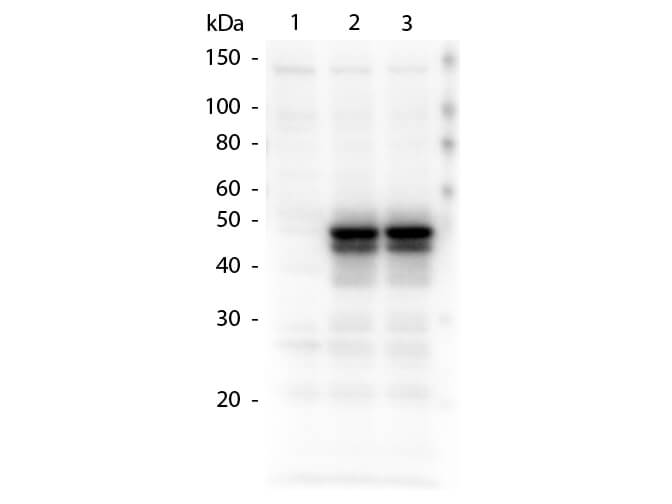Anti-Hice1 (Rabbit) Antibody
HICE1 Antibody
- SPECIFICATION
- CITATIONS
- PROTOCOLS
- BACKGROUND

| Host | Rabbit |
|---|---|
| Conjugate | Unconjugated |
| Target Species | Human |
| Reactivity | Human |
| Clonality | Polyclonal |
Application
| WB, E, I, LCI |
| Application Note | Hice1 antibody has been tested for use in ELISA and by western blot. Specific conditions for reactivity should be optimized by the end user. Expect a band approximately 44.9 kDa in size corresponding to human Hice1 protein by western blotting in the appropriate stimulated tissue or cell lysate or extract. |
| Physical State | Liquid (sterile filtered) |
| Buffer | 0.02 M Potassium Phosphate, 0.15 M Sodium Chloride, pH 7.2 |
| Immunogen | Anti-Hice1 Antibody was prepared by repeated immunizations with a synthetic peptide corresponding to the region of amino acids containing serine 70 of human Hice1. |
| Preservative | 0.01% (w/v) Sodium Azide |
| Gene ID | 93323 |
|---|---|
| Other Names | 93323 |
| Purity | Anti-Hice1 Affinity purified antibody is directed against human Hice1 protein. The product was affinity purified from monospecific antiserum by immunoaffinity purification. A BLAST analysis was used to suggest cross reactivity with Hice1 from human based on 100% sequence homology with the immunogen. Reactivity against homologues from other sources is not known. |
| Storage Condition | Store vial at -20° C prior to opening. Aliquot contents and freeze at -20° C or below for extended storage. Avoid cycles of freezing and thawing. Centrifuge product if not completely clear after standing at room temperature. This product is stable for several weeks at 4° C as an undiluted liquid. Dilute only prior to immediate use. |
| Precautions Note | This product is for research use only and is not intended for therapeutic or diagnostic applications. |
| Name | HAUS8 |
|---|---|
| Synonyms | HICE1 |
| Function | Contributes to mitotic spindle assembly, maintenance of centrosome integrity and completion of cytokinesis as part of the HAUS augmin-like complex. |
| Cellular Location | Cytoplasm. Cytoplasm, cytoskeleton, microtubule organizing center, centrosome. Cytoplasm, cytoskeleton, spindle. Cytoplasm, cytoskeleton, spindle pole. Note=During interphase, primarily cytoplasmic and associates with centrosomes and with the mitotic spindles, preferentially at the spindle pole vicinity. During anaphase and telophase, additionally associates with the spindle midzone and midbody, respectively. Localizes to mitotic spindle microtubules |

Thousands of laboratories across the world have published research that depended on the performance of antibodies from Abcepta to advance their research. Check out links to articles that cite our products in major peer-reviewed journals, organized by research category.
info@abcepta.com, and receive a free "I Love Antibodies" mug.
Provided below are standard protocols that you may find useful for product applications.
Background
Hice1 is designed, produced, and validated as part of a collaboration between Rockland and the National Cancer Institute (NCI) and is suitable for Cancer, Immunology and Nuclear Signaling research. Hice1 contributes to the mitotic spindle assembly, maintenance of centrosome integrity and completion of cytokinesis as part of the HAUS augmin-like complex. Normal bipolar spindle formation is critical for accurate chromosome segregation and proper mitotic progression. Failure in this event leads to spindle checkpoint activation and chromosome missegregation that ultimately leads to aneuploidy. Hice1 binds to microtubules directly, and promotes spindle integrity and chromosome stability. Hice1 has also shown to play an important role in targeting the gamma TuRC complex to the mitotic spindle, a step that appears to be required for spindle-mediated microtubule generation and normal chromosome segregation. The HAUS augmin-like complex's interaction with microtubules is strong during mitosis, while it is weak or absent during interphase. During interphase, it is primarily cytoplasmic, associating with centrosomes and with the mitotic spindles, preferentially at the spindle pole vicinity. During anaphase and telophase, it additionally associates with the spindle midzone and midbody, respectively. Further characterization of the function of Hice1 will likely be important for better understanding the mechanism of normal mitotic progression and high fidelity chromosome segregation.
If you have used an Abcepta product and would like to share how it has performed, please click on the "Submit Review" button and provide the requested information. Our staff will examine and post your review and contact you if needed.
If you have any additional inquiries please email technical services at tech@abcepta.com.













 Foundational characteristics of cancer include proliferation, angiogenesis, migration, evasion of apoptosis, and cellular immortality. Find key markers for these cellular processes and antibodies to detect them.
Foundational characteristics of cancer include proliferation, angiogenesis, migration, evasion of apoptosis, and cellular immortality. Find key markers for these cellular processes and antibodies to detect them. The SUMOplot™ Analysis Program predicts and scores sumoylation sites in your protein. SUMOylation is a post-translational modification involved in various cellular processes, such as nuclear-cytosolic transport, transcriptional regulation, apoptosis, protein stability, response to stress, and progression through the cell cycle.
The SUMOplot™ Analysis Program predicts and scores sumoylation sites in your protein. SUMOylation is a post-translational modification involved in various cellular processes, such as nuclear-cytosolic transport, transcriptional regulation, apoptosis, protein stability, response to stress, and progression through the cell cycle. The Autophagy Receptor Motif Plotter predicts and scores autophagy receptor binding sites in your protein. Identifying proteins connected to this pathway is critical to understanding the role of autophagy in physiological as well as pathological processes such as development, differentiation, neurodegenerative diseases, stress, infection, and cancer.
The Autophagy Receptor Motif Plotter predicts and scores autophagy receptor binding sites in your protein. Identifying proteins connected to this pathway is critical to understanding the role of autophagy in physiological as well as pathological processes such as development, differentiation, neurodegenerative diseases, stress, infection, and cancer.


